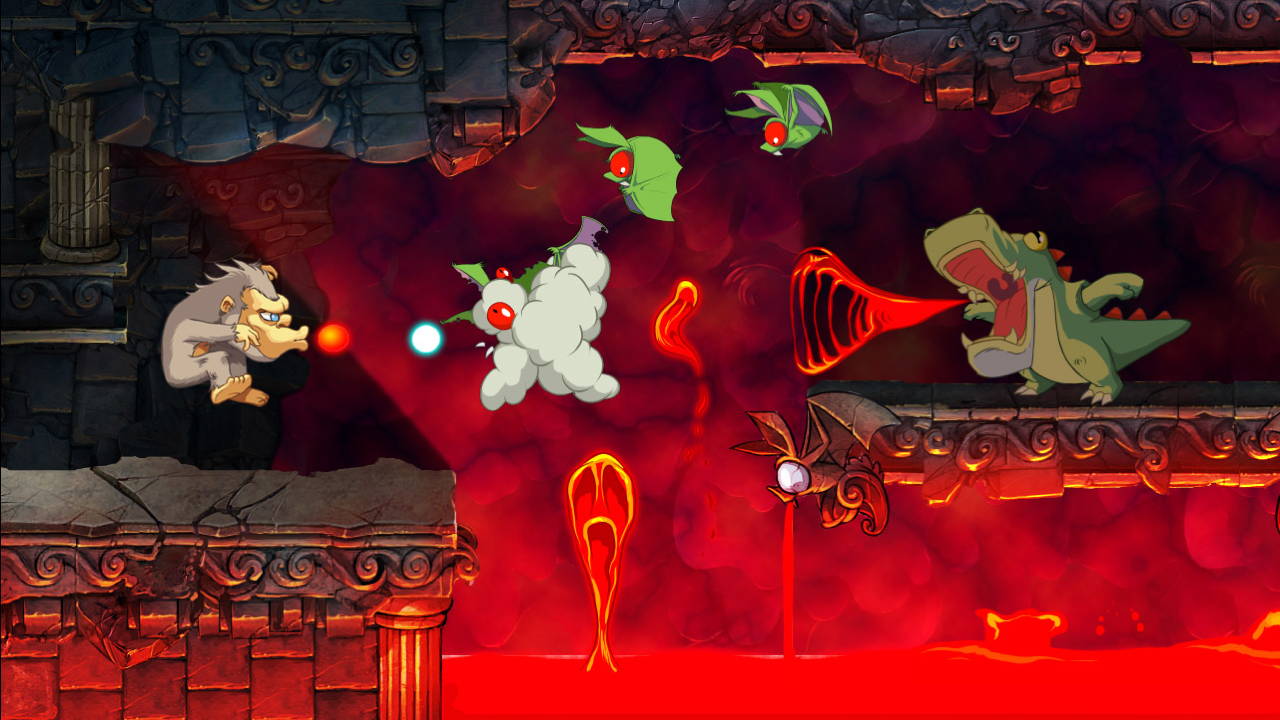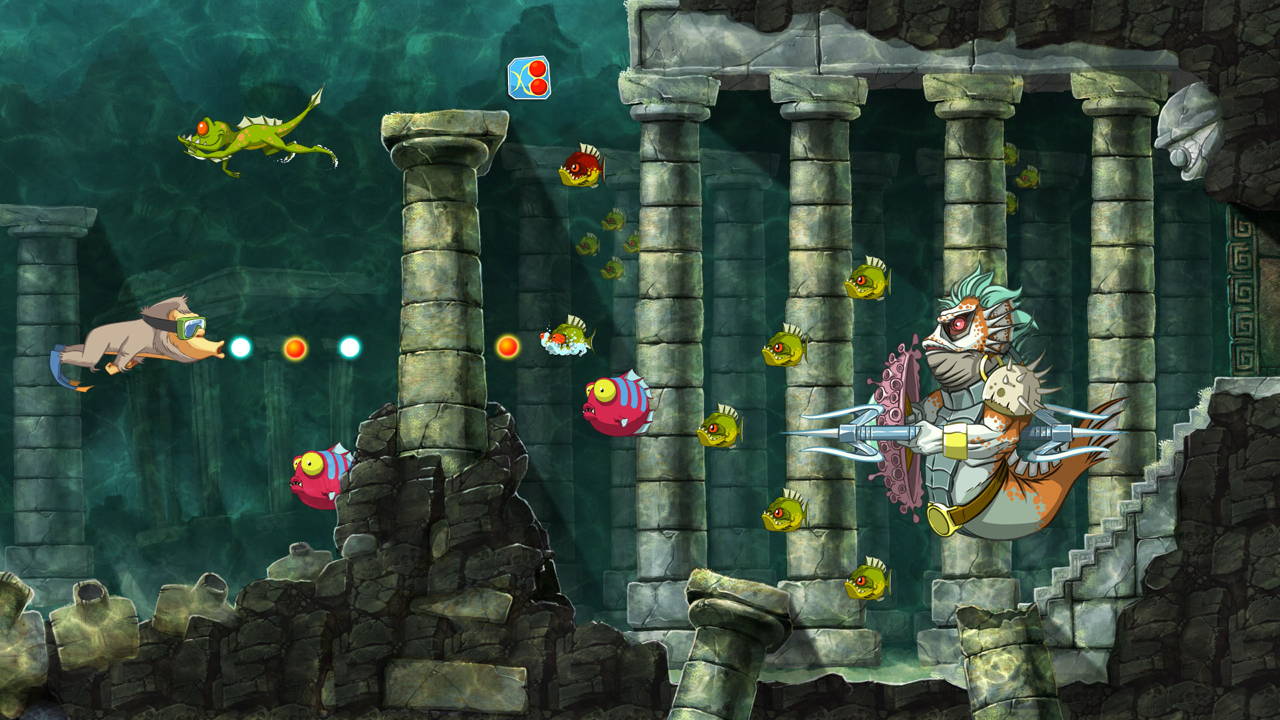Search
[{{{type}}}] {{{reason}}}
{{/data.error.root_cause}}{{{_source.title}}} {{#_source.showPrice}} {{{_source.displayPrice}}} {{/_source.showPrice}}
{{#_source.showLink}} {{/_source.showLink}} {{#_source.showDate}}{{{_source.displayDate}}}
{{/_source.showDate}}{{{_source.description}}}
{{#_source.additionalInfo}}{{#_source.additionalFields}} {{#title}} {{{label}}}: {{{title}}} {{/title}} {{/_source.additionalFields}}
{{/_source.additionalInfo}}- Details
- Category: Switch
- By Cinque Pierre
- Hits: 3738
Toki (Switch)

Toki
Developed By: Microids
Published By: Microids
Released: Dec 4, 2018
Available On: Switch
Genre: Arcade, Platformer, Shoot ‘em up
ESRB Rating: E10+ for everyone 10 and up: Fantasy Violence, Mild Blood
Number of Players: Single-player
Price: $29.99
Thank you Microids for sending us a review code!
The days of the arcade are long past us. With consoles and handhelds in general being more affordable to the average consumer, this means that many games will not have certain arcadic, quarter-crunching features and opt in for microtransactions to make a profit instead. Toki, developed and published by Microids, is of the former statement, reminiscent of what some may say are “the good ol’ days.”
Some of you older readers might be familiar with the name Toki, as this Toki is a remake of the 1989 game of the same name (also known as Juju Densetsu in Japan). I personally wasn’t familiar with Toki at all before reviewing this game, so I simply thought it was an indie game that took inspiration from the crazy hard arcade games of the past. For those unfamiliar with Toki, the game stars the titular character, a tribesman who is turned into an ape creature by the evil sorcerer Vookimedlo. The demon Bashtar, working alongside Vookimedlo, kidnaps Miho, Toki’s beloved. That’s the general premise of the story. Arcade games did not, or simply could not have the expansive narratives of games today—as it is just an excuse to get the ball rolling. Don’t expect an award-winning plot—it did originally come out in 1989, after all.
Toki immediately starts off with no tutorial, but teaches you from experience, with the very first enemy taking cues from the most famous goomba of our time—walking very slowly towards you. For people who have played platformers before, your first instinct will be to jump on the enemy, and thus would be rewarded with a defeated enemy. Others may try and press all the buttons to see what they do, and will also be rewarded with a projectile shot out of Toki’s mouth in a rather exaggerated fashion. Now for the reasons why Donkey Kong’s estranged cousin can shoot Contra bullets out of his mouth… Your guess is as good as mine; It is what it is after all. Controls are rather simple, with B and X to shoot, and A and Y to jump. The control stick and directional buttons are to aim horizontally or diagonally. Be aware, as Toki has not mastered the ability to shoot and run at the same time. Fortunately, Toki can shoot as fast as you can mash the button.
Throughout the levels, there are various powerups that can be collected, such as a football helmet that protects your front from damage, sneakers that give you higher jump, and a wide variety of different patterns, such as a spreader, wave-like shots, bigger bullets, and a flame breath. These powerups only last for a limited time. Let's go back to the football helmet and sneakers for a moment. The setting is all over the place and doesn’t take itself seriously, as there is an almost nonsensical blend of ancient and modern set pieces all throughout the game. As Toki is an arcade game, every action earns points, and earning enough points gets you an extra life.

Strong Points: Fluid hand-drawn graphical style; simple to play, and responsive; very faithful to the original 1989 classic
Weak Points: A bit too faithful, especially for its price range and short length; the majority of the challenge comes from trial and error situations
Moral Warnings: The damsel in distress is immodestly dressed, showing off excess cleavage and midriff; the penultimate and final bosses have hearts that can be attacked, which also bleed and explode; the sorcerer Vookimedlo uses magic to transform our main character into an ape man; a demon by the name of Bashtar works for Vookimedlo
Like most shoot ‘em up games, Toki tends to die in one hit from basically everything. Of course dying in one hit isn’t a feature exclusive to games of this genre, but current games give you infinite lives if they so happen to be on the more challenging side. Toki, however, is pretty generous with checkpoints, though in some cases, there are a few checkpoints that could be better placed as an enemy will immediately attack at some of them. Four difficulties are available for Toki, ranging from Easy (which gives you 9 lives and 9 credits) all the way to Hardest (which gives you 2 lives, 3 credits, and makes enemies withstand more damage). Even on the easiest difficulty, Toki can present quite the challenge and my first playthrough had me use almost all of my credits to beat the game. A lot of the game is a genuine challenge, but like most arcade games of that time, Toki suffers from trial and effort that can result from cheap deaths (and would be another quarter or quarters spent back in the day).
Toki went through quite the troubled development cycle. This remake was originally announced way back in 2009 by Golgoth Studio, and was suppose to come out for the consoles of that era, as well as the Steam platform in 2011. It just so happened to miss that period by a long shot. It would go through moments where it would be mentioned here and there to let people know that the game wasn’t canceled. In 2018, it would the be picked up by the French developer Microids and announced to come out exclusively for the Switch for a late 2018 release. I’m assuming it came out only for the Switch because of how well-received and successful indie games have been doing on the platform. I can also make another guess as to why Toki took so long to come out in the first place.
Everything in Toki is hand-drawn. I’m a huge sucker for anything hand-drawn, as animation can express thoughts, feelings, and ideas in a way that words cannot. The hand-drawn animation style seems to become less popular as the years go by over digital animation as digital animation takes less effort to do well in, and is way less time consuming. Digital animation does have its upsides, but compared to hand-drawn, it lacks the fluidity that the latter tends to possess. In a way I am glad that France hasn’t forgotten about the wonders of hand-drawn animation. They also seem to be one of the last bastions to hold on to the tried-and-true pen and paper, as mostly everyone either traded in the old fashioned weapons for a Cintiq and slap it in your choice of Flash, Toon Boom—or outsources their animation to Korea.

Higher is better
(10/10 is perfect)
Game Score - 76%
Gameplay - 12/20
Graphics - 9/10
Sound - 7/10
Stability - 5/5
Controls - 5/5
Morality Score - 84%
Violence - 6.5/10
Language - 10/10
Sexual Content - 8.5/10
Occult/Supernatural - 7/10
Cultural/Moral/Ethical - 10/10
Anyways, Toki’s graphics are a sight to behold, as each enemy is expressive and all have their own unique walking, attacking, and death animations. This even applies to our hero himself. Backgrounds and scenery are quite the sight to behold, with areas going from jungles, ice tundras, volcanic caverns, and a rather modern-looking palace. Each level is very unique from each other, and aesthetics-wise looks far superior to its 1989 counterpart. The orchestrated music complements the bouncy art style of the game. For someone who has to save their beloved from the clutches of evil, he does have a rather chill expression and walking animation. It’s almost like he doesn’t have a care in in the world, with his head bobbing and arms dangling so nonchalantly.
The 1989 version didn’t have much in the way of moral concerns and warnings, besides the usage of magic by the sorcerer Vookimedo who turns Toki into the ape man you are playing as. Interestingly enough, the remake does have a few more concerns at hand. As expected of a French developer, both Toki and Miho show off more skin, with Miho in particular showing off her midriff and cleavage. There is one zombie-like ape enemy encountered many times throughout the game. Bashtar is a demon, and also exists as the fifth levels' boss. You attack his heart, while his appendages show off the bone of where an arm or leg would be attached. Vookimedlo, when accepting his untimely death (for him) is rather explosive, as his heart bleeds in a striking fashion. Not sure what the ESRB meant by “mild.”
I have played and beaten Toki a few times—though I have yet to beat it on Hardest. As I grew up in the days of the arcade and like a game that presents a challenge, I have personally enjoyed my half dozen or so attempts. I assumed that at first, it was a $10-$15 game, and would be able to recommend it to most people, but even with spectacular animation, and being faithful to the original, a 30 dollar price range might be asking too much for the average game player. I understand that animation is not a cheap endeavor if you want it to look good, but 2018’s Toki is a bit too faithful for its own good to the 1989 counterpart—where the only real difference is the graphical approach and musical style. For most players, they will play the game once or twice, which will take an hour and a half at the very most to complete, and then forget about it. Even if the game is mostly safe for children, the children of today may not like the dated mechanics or the gut-punching difficulty so it’s hard to recommend for them. There is a very valid reason to why video games have mostly moved on from the archaic approach of artificially lengthening of a game in favor for the dozens to hundreds of hours of grind that many modern games use. Unless you really love arcade shoot 'em ups, it would be best to wait for a sale.








